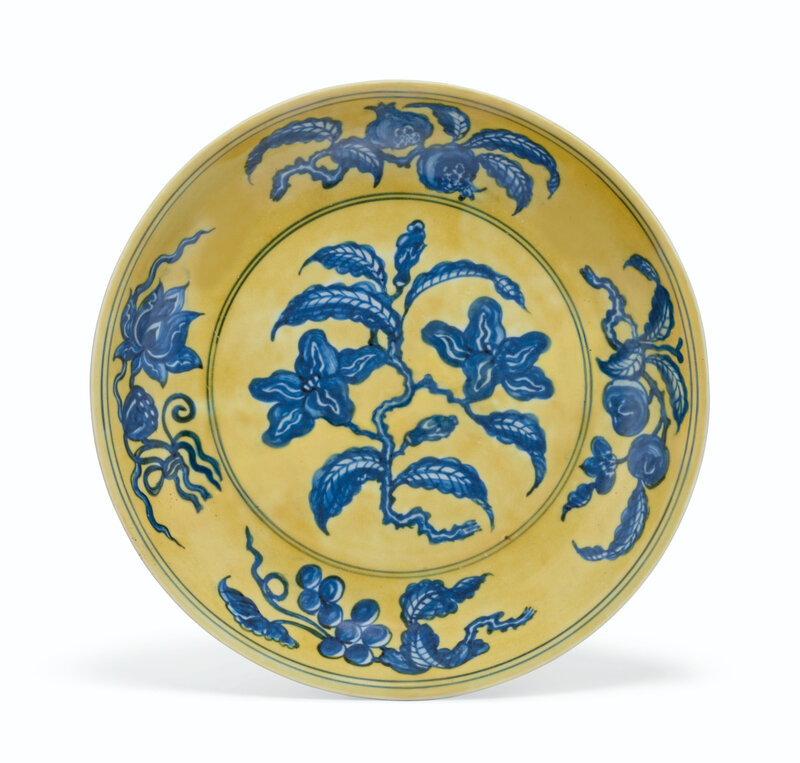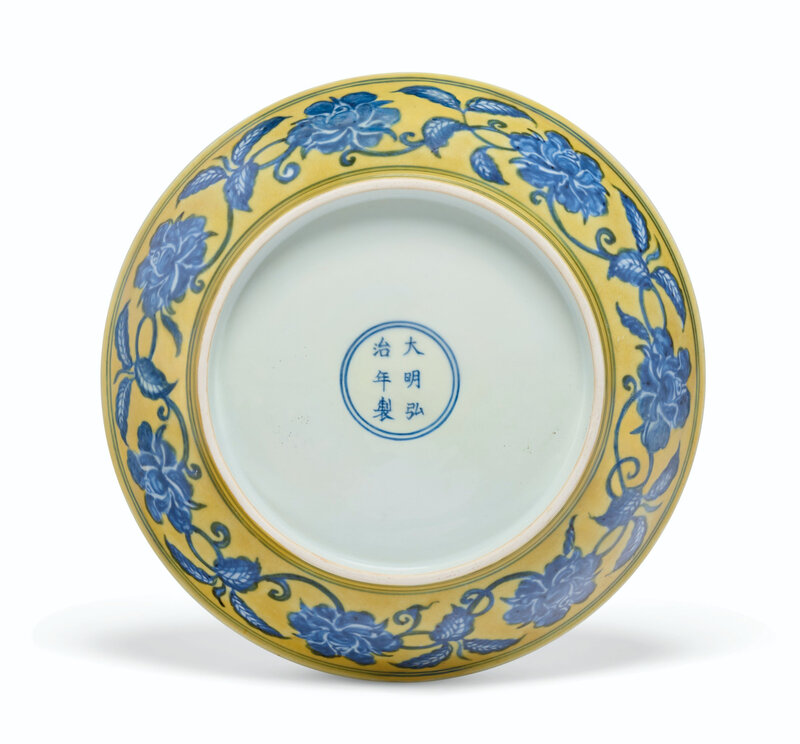The center is decorated with a gardenia spray bearing two blossoms, below sprays of pomegranate, lotus, grape and rose in the well, with a frieze of flower scroll on the exterior, all in shaded tones of underglaze blue and reserved on a soft lemon-yellow ground, cloth box.
Provenance: Sotheby's Hong Kong, 27 October 1993, lot 62.
The Lenora and Walter F. Brown Collection, San Antonio, Texas.
Literature: Amy Lewis Hofland and Shiyuan Yuan, Texas Collects Asia, Dallas, 2008, p. 168, no. 51.
Exhibited: Dallas, The Trammell & Margaret Crow Collection of Asian Art, Texas Collects Asia, 12 July-28 September 2008, no. 51.
Note: A Hongzhi-marked dish of the same design and size is illustrated in The Complete Treasures of the Palace Museum - 35 - Blue and White Porcelain with Underglaze Red (I), Hong Kong, 2000, p. 256, no. 231.
Dishes of this design, featuring underglaze-blue decoration against an enameled yellow ground, first appeared in the Xuande period (1426-1435), such as the example included in the exhibition, Xuande Imperial Porcelain Excavated at Jingdezhen, Chang Foundation, Taiwan, illustrated in the Catalogue, no. 88. This design found much popularity in the mid-Ming period and similar dishes were produced in varying sizes with either a pomegranate or a stylized flower, often identified as gardenia, in the interior. Published examples bear the Chenghua, Hongzhi, Zhengde and Jiajing reign marks.
Christie's. Important Chinese Ceramics and Works of Art, New York, 25 September 2020

/https%3A%2F%2Fprofilepics.canalblog.com%2Fprofilepics%2F1%2F0%2F100183.jpg)
/https%3A%2F%2Fstorage.canalblog.com%2F03%2F02%2F119589%2F96711876_o.jpg)
/https%3A%2F%2Fstorage.canalblog.com%2F11%2F31%2F119589%2F94773502_o.jpg)
/https%3A%2F%2Fstorage.canalblog.com%2F20%2F83%2F119589%2F94772815_o.jpg)
/https%3A%2F%2Fstorage.canalblog.com%2F26%2F72%2F119589%2F75604929_o.jpg)
/https%3A%2F%2Fstorage.canalblog.com%2F59%2F60%2F119589%2F26458628_o.jpg)




/image%2F1371349%2F20240416%2Fob_2a8420_437713933-1652609748842371-16764302136.jpg)
/image%2F1371349%2F20240414%2Fob_83ee65_2024-nyr-22642-0954-000-a-blue-and-whi.jpg)
/image%2F1371349%2F20240414%2Fob_15808c_2024-nyr-22642-0953-000-a-blue-and-whi.jpg)
/image%2F1371349%2F20240414%2Fob_e54295_2024-nyr-22642-0952-000-a-rare-blue-an.jpg)